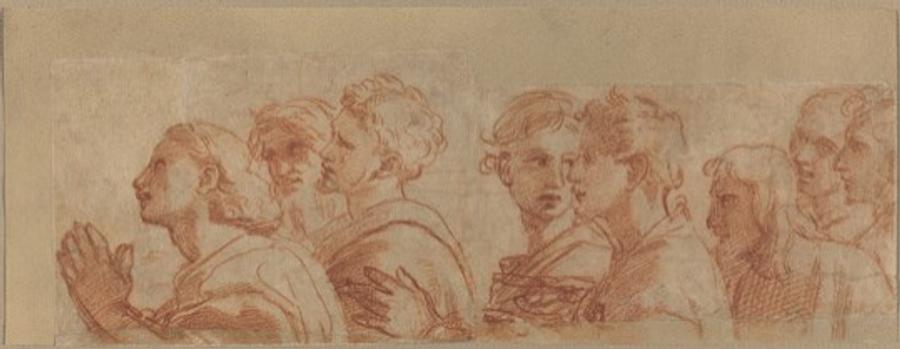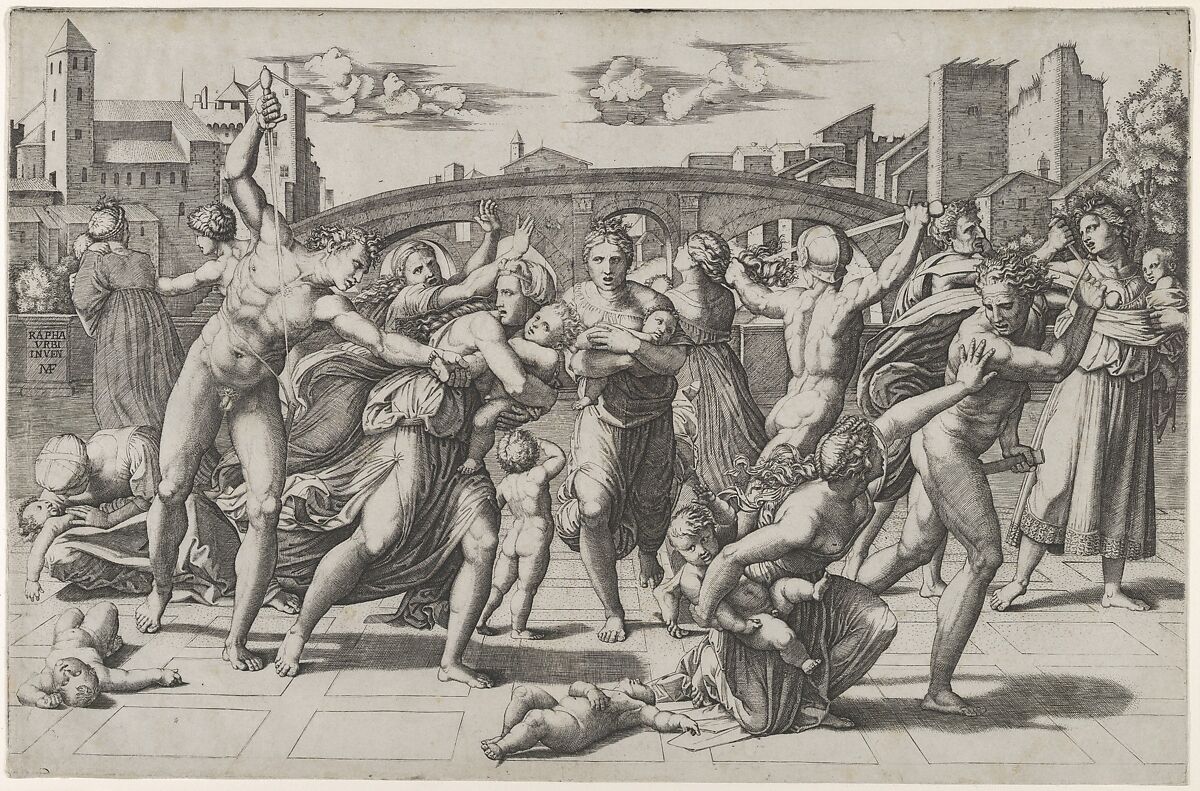
Raphael (1483–1520) was the first and greatest figure
in the modern classical tradition of Western art. In celebration of the
500th anniversary of his death, the National Gallery of Art will present
26 prints and drawings from its own collection of works by Raphael’s
contemporaries as well as four drawings by the Renaissance master
himself. Raphael and His Circle will convey
the complexity, range, and immediate influence of his style as it became
the standard for aesthetic excellence in Western art. The exhibition
will be on view from February 16 through June 14, 2020.
Raphael 500
Several major exhibitions have been organized to mark the 500th anniversary of Raphael’s death. The Gallery will lend several important works to these exhibitions while offering its own homage through this exhibition and the continuing permanent display of its five paintings by Raphael—the largest and most important group outside of Europe. The Galleria Nazionale delle Marche inaugurates the year’s tribute with an exhibition in his hometown of Urbino (Raphael and His Friends of Urbino, October 3, 2019–January 19, 2020). The celebration continues with exhibitions at the Scuderie del Quirinale, Rome, and the National Gallery, London (The Credit Suisse Exhibition: Raphael, October 3, 2020–January 24, 2021). At the Veneranda Biblioteca Ambrosiana, Milan, a newly conserved preparatory cartoon (c. 1508) for the Vatican fresco School of Athens (1509) is on view. The Victoria and Albert Museum, London, will be highlighting their set of seven full-scale cartoons by Raphael for tapestries.
Several major exhibitions have been organized to mark the 500th anniversary of Raphael’s death. The Gallery will lend several important works to these exhibitions while offering its own homage through this exhibition and the continuing permanent display of its five paintings by Raphael—the largest and most important group outside of Europe. The Galleria Nazionale delle Marche inaugurates the year’s tribute with an exhibition in his hometown of Urbino (Raphael and His Friends of Urbino, October 3, 2019–January 19, 2020). The celebration continues with exhibitions at the Scuderie del Quirinale, Rome, and the National Gallery, London (The Credit Suisse Exhibition: Raphael, October 3, 2020–January 24, 2021). At the Veneranda Biblioteca Ambrosiana, Milan, a newly conserved preparatory cartoon (c. 1508) for the Vatican fresco School of Athens (1509) is on view. The Victoria and Albert Museum, London, will be highlighting their set of seven full-scale cartoons by Raphael for tapestries.
Exhibition Organization
The exhibition is organized by the National Gallery of Art, Washington.
Exhibition Curator
The exhibition is curated by Jonathan Bober, Andrew W. Mellon Senior Curator of Prints and Drawings, National Gallery of Art.About the Exhibition.
About the Exhibition
Raphael and His Circle features 26 prints and drawings by Raphael’s collaborators and followers, and by printmakers who were inspired by him. The exhibition includes four drawings by Raphael from the Gallery’s collection: the sheet from which the design of his painting Saint George and the Dragon (c. 1506, National Gallery of Art, Washington) was transferred; the cartoon for the so-called Belle Jardinière (La Vierge à l'Enfant avec le petit saint Jean-Baptiste, 1507 or 1508, Musée du Louvre, Paris); a detailed representation of the prophets Hosea and Jonah; and a well-known study for part of the frescoes in the church of Santa Maria della Pace in Rome. Each of these drawings is an advanced preparatory study for an important extant work. Together they represent Raphael’s immediate influence and artistic development.
Nine drawings by his closest collaborators and followers suggest the collective nature of Raphael’s later activity and the origins of mannerism. Four pen-and-ink drawings by Giulio Romano (1499–1546) include a dramatic rendering of Saint Michael (c. 1530). Two chalk drawings by Polidoro da Caravaggio (c. 1499–probably 1543) feature a fleeing barbarian from the early 1520s and A Deathbed Scene (c. 1521/1522) with a drawing of a seated woman on the reverse in red chalk. Also on view are two pen-and-ink drawings by Perino del Vaga (1501–1547), including the remarkable Alexander Consecrating the Altars for the Twelve Olympian Gods (1545/1547) and a sheet of figure studies.
Raphael was the first artist to exploit the possibilities of printmaking to disseminate his inventions, enhance his reputation, and generate income. This practice caused his art to become a universal European language. Raphael’s prints demonstrated to an international audience his magisterial command of complex, multifigure compositions and his modern style rooted in the study of ancient art.
This exhibition includes 10 engravings by one of the earliest interpreters of his designs,
Marcantonio Raimondi (c. 1480–c. 1534), whose engravings of Parnassus and The Holy Family,

as well as The Massacre of the Innocents (c. 1511) show Raphael’s influence.
Around 1510 Raphael began collaborating with Marcantonio on several engravings that successfully circulated Raphael’s works beyond the Roman churches and palaces in which they were housed.
Raimondi’s followers, Agostino dei Musi (c. 1490–1536) and Marco Dente (c. 1493–1527), also directly reference works by Raphael in their engravings,

including Musi’s The Battle with the Cutlass.

Also on view is Ugo da Carpi’s (c. 1480–1532) David Slaying Goliath, based on a design by Raphael in the Vatican, which is the only chiaroscuro woodcut in the exhibition.
The exhibition is organized by the National Gallery of Art, Washington.
Exhibition Curator
The exhibition is curated by Jonathan Bober, Andrew W. Mellon Senior Curator of Prints and Drawings, National Gallery of Art.About the Exhibition.
About the Exhibition
Raphael and His Circle features 26 prints and drawings by Raphael’s collaborators and followers, and by printmakers who were inspired by him. The exhibition includes four drawings by Raphael from the Gallery’s collection: the sheet from which the design of his painting Saint George and the Dragon (c. 1506, National Gallery of Art, Washington) was transferred; the cartoon for the so-called Belle Jardinière (La Vierge à l'Enfant avec le petit saint Jean-Baptiste, 1507 or 1508, Musée du Louvre, Paris); a detailed representation of the prophets Hosea and Jonah; and a well-known study for part of the frescoes in the church of Santa Maria della Pace in Rome. Each of these drawings is an advanced preparatory study for an important extant work. Together they represent Raphael’s immediate influence and artistic development.
Nine drawings by his closest collaborators and followers suggest the collective nature of Raphael’s later activity and the origins of mannerism. Four pen-and-ink drawings by Giulio Romano (1499–1546) include a dramatic rendering of Saint Michael (c. 1530). Two chalk drawings by Polidoro da Caravaggio (c. 1499–probably 1543) feature a fleeing barbarian from the early 1520s and A Deathbed Scene (c. 1521/1522) with a drawing of a seated woman on the reverse in red chalk. Also on view are two pen-and-ink drawings by Perino del Vaga (1501–1547), including the remarkable Alexander Consecrating the Altars for the Twelve Olympian Gods (1545/1547) and a sheet of figure studies.
Raphael was the first artist to exploit the possibilities of printmaking to disseminate his inventions, enhance his reputation, and generate income. This practice caused his art to become a universal European language. Raphael’s prints demonstrated to an international audience his magisterial command of complex, multifigure compositions and his modern style rooted in the study of ancient art.
This exhibition includes 10 engravings by one of the earliest interpreters of his designs,
Marcantonio Raimondi (c. 1480–c. 1534), whose engravings of Parnassus and The Holy Family,
as well as The Massacre of the Innocents (c. 1511) show Raphael’s influence.
Around 1510 Raphael began collaborating with Marcantonio on several engravings that successfully circulated Raphael’s works beyond the Roman churches and palaces in which they were housed.
Raimondi’s followers, Agostino dei Musi (c. 1490–1536) and Marco Dente (c. 1493–1527), also directly reference works by Raphael in their engravings,
including Musi’s The Battle with the Cutlass.

Also on view is Ugo da Carpi’s (c. 1480–1532) David Slaying Goliath, based on a design by Raphael in the Vatican, which is the only chiaroscuro woodcut in the exhibition.
Raphael (1483–1520)
Raffaelo di Giovanni Santi, known as Raphael, was a younger contemporary of Leonardo da Vinci and Michelangelo, all of whom epitomize the High Renaissance in Italy. It is thought that Raphael’s early training was with his father, who was a painter at the court of Urbino. He joined the workshop of Pietro Perugino sometime after the death of his father, when Raphael was 11 years old.
Late in 1504, Raphael moved to Florence, drawn by Leonardo’s softly shadowed forms, natural figure groupings, and simplified settings. In 1508 the pope summoned Raphael to Rome, where he was influenced by the idealized classical art of the city's ancient past. He also responded to the more energetic and physical style of Michelangelo, whose works he had already begun to study in Florence. Raphael remained in Rome for the last 12 years of his life, preparing monumental frescoes for the papal chambers, designing tapestries for the Sistine Chapel, and painting mythological scenes. He was also the city’s leading portraitist, creating penetrating images that engage viewer and sitter with a new intensity for the time. When he died at age 37, the pope ordered that Raphael, who had been keeper of antiquities, be buried in the Pantheon.
Raffaelo di Giovanni Santi, known as Raphael, was a younger contemporary of Leonardo da Vinci and Michelangelo, all of whom epitomize the High Renaissance in Italy. It is thought that Raphael’s early training was with his father, who was a painter at the court of Urbino. He joined the workshop of Pietro Perugino sometime after the death of his father, when Raphael was 11 years old.
Late in 1504, Raphael moved to Florence, drawn by Leonardo’s softly shadowed forms, natural figure groupings, and simplified settings. In 1508 the pope summoned Raphael to Rome, where he was influenced by the idealized classical art of the city's ancient past. He also responded to the more energetic and physical style of Michelangelo, whose works he had already begun to study in Florence. Raphael remained in Rome for the last 12 years of his life, preparing monumental frescoes for the papal chambers, designing tapestries for the Sistine Chapel, and painting mythological scenes. He was also the city’s leading portraitist, creating penetrating images that engage viewer and sitter with a new intensity for the time. When he died at age 37, the pope ordered that Raphael, who had been keeper of antiquities, be buried in the Pantheon.